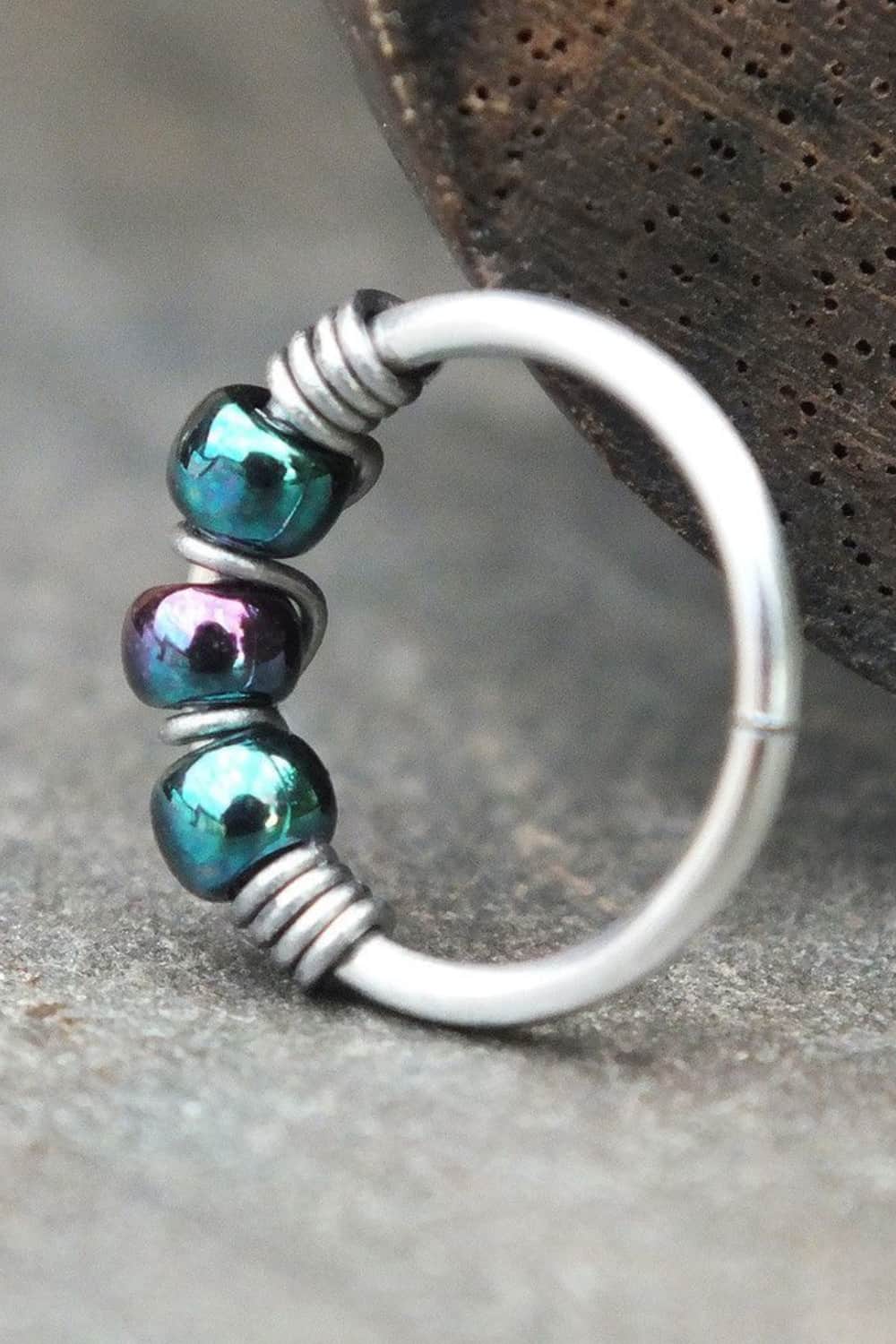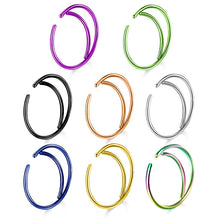
Jun 2022
0 Comments
The 10 most common types of nose rings
Nose rings come in many styles, so you can opt for a slightly less hurtful version for your nose accessory. Of course, this is technically a nose hoop, not a nose stud.

There's another kind of ring called the septum ring, but we're outdoing ourselves. Before we look at the most common types of nose rings, we must do some background work on piercings and jewelry hygiene. You can choose to Pierce the nostrils, septum, or bridge of the nose. Each piercing requires a different type of nose ring based on positioning.
And of course, if your septum deviates, you shouldn’t get it pierced, so double-check! The healing time for nose rings can be anything from 8 weeks to 8 months, depending on where, how, and who performed your piercing. You’ll have to keep in the original nose ring until you’re fully healed, then you can swap out your jewelry. That’s why it helps to get it right from the start.
Nose Ring Materials
A nose ring can range from cheap plastic to pricy platinum. If you have metal allergies, these two fringe materials are the best fit. The plastic might be bioplast or acrylic, and you can also buy a nose ring made of glass. Other options are stainless steel, sterling silver, white gold, yellow gold, and titanium. You can opt for a nose ring with a meaningful gemstone or cheaper rhinestones.
Keep an eye out for piercing migration. That’s when your ‘hole’ starts to move or expand as it heals. In some cases, this can be a good thing, as in the case of deliberate stretching. But sometimes, the migration can cause bumps and scars. Bridge piercings are the most susceptible to migration, so consider getting a nose ring with some wiggle room such as a curved barbell.
The type and location of your nose piercing can dictate the type of nose ring material. If you have a double or triple piercing, you may need twisted or hooked barbells, while a high nostril piercing is better suited for a stud. These types of nose rings are intricate, so they have to be made from a sturdy but ductile metal that won’t weaken at the curves or joints. They may need sizing.
Most Common Types Of Nose Rings
Depending on where you look and who you ask, nose rings could be categorized into five categories or even fifty-five! Think about the thickness of your nose ring – it ranges from thin 22-gauge to thicker 18-gauge. Length matters too because if your nose membrane is thicker, you need a nose ring with a longer stem. Also, factor in the position of your piercing:
- Third eye – vertical double piercing between your eyes.
- Bridge – horizontal double piercing below the third eye ‘where your nose starts’.
- Nasallang – horizontal double piercing on the upper part of your nose.
- Septum – horizontal single piercing on the skin that separates your two nostrils.
- Septril – single piercing at the tip of your septum.
- Rhino – vertical double piercing at the tip of your nose, slightly above the septril.
- Nostril – single piercing on your mid-lower nostril.
- High nostril – single piercing on your upper nostril, closer to the bridge.
- Austin – double horizontal piercing on your lower nostril, closer to the tip.
Also, if you add a gemstone, it can be set using prongs or a bezel. Prongs might snag your hair and clothing, so some consumers are wary of them. But bezels let less light pass through them, so they’re not as sparkly. Let’s look at the most common styles and how they suit you.
1. Corkscrew / Twist / Nostril Screw
This type of nose ring has a beat at the top, a straight stem, and a c-shaped hook at the bottom. You have to coil it into your nostril and the hook lies flush against the inner roof of your nose. The tip of the hook sometimes pokes out your nostril, especially after sneezing or sweating.
That makes some consumers self-conscious. You might find yourself constantly touching your nose and picking at it to check if the hook is loose. Twist nose rings are best for nostril and high nostril piercings. Buy it in person to be sure the stem fits the thickness of your nose.
2. L-Shaped / L-Post
This design is similar to corkscrews, but instead of the stem curling and hooking at the tip, it bends at 90°. Like the corkscrew, the L-section sits against the upper inside roof of your nose. It’s less fussy without the hook, but isn’t as snug on thicker nose membranes and may pinch. It does slip out sometimes though. It’s suitable for nostril and high nostril positioning.
3. Labret

In this type of nose ring, both ends of the stem are flat, and one part screws off. So you’ll insert the nose ring from the inside of your nostril then screw on the top part on the outside of your nostril. There’s a potential hygiene risk since dirt can slip between the threads of the screw. It works best on high nostril and regular nostril piercings and can be quite elaborate on top.
4. Nose Bone / Stud
These are similar to labrets, but instead of flat tips, the nose ring has a ball on both ends. The outer tip could be a gemstone while the inner ball is metal. The inner ball should be small enough to squeeze through your piercing with a little effort but it won’t slip out unless you actively yank it because the inner ball functions as a stopper. Only buy this type after healing.
5. Barbell

Barbell nose rings resemble labrets, but instead of flat tips, they have a screwed-on ball bead at each end of the stem. The shape of the stem determines the type. Curved barbells are ideal for bridges and rhinos due to the potential migration. Circular or horseshoe barbells are best for septum piercings. You can also get a twisted barbell for your nose if it’s carefully pierced to fit.
6. Pin / Fishtail / Bend-To-Fit
At first glance, this nose ring seems pretty simple. The top has a bead, gemstone, or shaped design and the extra-long stem is straight. After you put on the nose ring, your jeweler or piercer will bend the tip into a J-shape, a bit like a fish hook. The hooked isn’t sharp, but because the shop has to curl it for you, you have to go back every time you want to swap your jewelry.
7. Beaded Hoop / Captive Hoop / Bar Closure
This kind of nose ring is an actual thin ring and comes into two styles – closed and open. The open beaded hoop is horseshoe-shaped with a bead on one end to act as a stopper. It’s sometimes called a faux hoop. In the closed kind, one side of your hoop clicks into the bead to seal it shut and prevent it from slipping out of your piercing. It can look like a booger though.
8. Unbeaded Hoop / Seamless Hoop

This is a ring that you tug to open and compress to shut. Tension holds the hoop in place, and you can rotate it 360°. The hoop may have a little gap that you have to squeeze or one tip may be slim enough to slip into the other and click shut. It’s a good choice if you’re self-conscious about the bead in beaded hoops. Be careful with gapped ones though – they can pinch and get stuck.
9. Fake Hoop
We’ve mentioned that hoops with a bead and an ‘open latch’ can be labeled a faux hoop. This second type of faux hoop combines a hoop with an L-shaped nose ring. Outside your piercing, it looks like a hoop, but inside, the shaft folds into an L to maintain the illusion of a circle. The outer part of your hoop hooks into your nostril to complete the hooked effect.
10. Septum Clicker
The most common type of nose ring for a septum is a horseshoe barbell or circular barbell. It curls snugly through your septum and the beads at the tips keep it from popping back out. If you prefer a ‘closed’ look, you could wear a hoop in your septum. A septum clicker is a safer option though because it has a latch that can easily snap shut or click open when tugged.








